Celebrate St. Patrick’s Day in NYC 2025
Discover 10 ways to celebrate St. Patrick's Day in NYC this year, from eye-opening tours to Irish treats!

We talk about movie musicals, the NYC art scene, and the legacy of Westbeth with Gallery Director and artist Valerie Hallier!

Valerie Hallier wears a lot of hats, figuratively. She’s a single mom, an artist, a teacher, and now the Visual Art Chair and Gallery Director at Westbeth Gallery. Untapped New York Insiders will meet up with Hallier next week on an exclusive tour of Westbeth Artists Housing, so we sat down to learn more about the gallery, her role, and the larger arts community of New York City. In our conversation below, we discuss what drew Hallier from her native home of France to the busy streets of New York City, what exciting exhibits are in the works, how her teaching work helps her discover new parts of the five boroughs, and what’s next in her own artistic practice!
Hallier’s artwork has been shown internationally and throughout the United States, with solo shows at NARS Foundation, BRIC Arts Media, MediaNoche gallery, and CAS Arts Center in New York, in Europe at the ESAM in Caen, France and Nadiana Idriss Gallery in Berlin, Germany, and more. Most recently, Valérie received the Contemporary Arts Foundation and the MAAF (NYSCA &WaveFarm) Grants. Hallier also works as a teaching artist painting murals throughout the five boroughs with Public Schools for grades 1-12 and with Youth Development Programs.
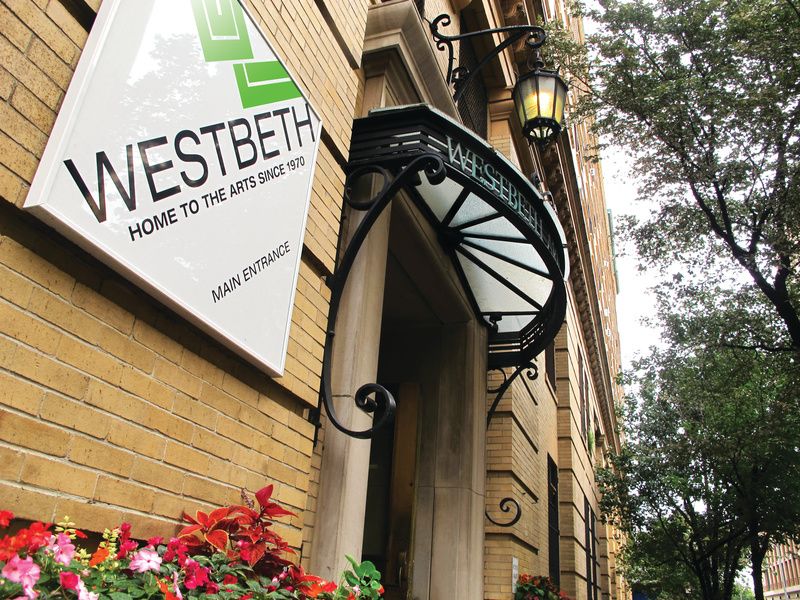
Westbeth Gallery is a nonprofit fine arts gallery located within Westbeth Artists Housing in Manhattan’s West Village. The gallery is operated by the Westbeth Artists Residents Council, a completely volunteer organization elected by the residents of Westbeth. The Westbeth Artists Residents Council (WARC) oversees the Westbeth Gallery and all artistic and cultural programming at Westbeth, such as the popular bi-annual flea market, music and movie nights, artist studio tours, and community-wide events.
Since the 1970s, the gallery has hosted shows featuring the work of Westbeth residents, like the late puppeteer Ralph Lee, New York City artists like Keith Haring (whose first solo exhibition, Des Refusés, was at the Westbeth Painters Space in 1981), and arts institutions like The Whitney, New York Foundation of the Arts, and more.
Join Untapped New York Insiders as we explore Westbeth Artists Housing and check out the current exhibition on display in the gallery, Synonymms: Rutgers University MFA Exhibit, with Hallier and Westbeth Artist Resident Council President Erin Quinn Purcell! This exclusive tour on June 22nd is free for Untapped New York Insiders! Not an Insider yet? Become a member today with promo code JOINUS and get your first month free!
Valerie Hallier: The culture mostly. I was fascinated with musicals, movie musicals. My master’s thesis was titled “Can We Still Sing in the Rain?” and it was about debunking musicals, what worked, why it stopped, and all that. Meanwhile, I loved, also all the modern art, expressionist abstraction, and all those things. I was also very enamored with Andy Warhol and all that.
I came to visit once with my boyfriend back then, and I just thought, “I could never get bored in this city, this is where I want to be.” And he looked at me and was just like, “I never want to live here!” Needless to say, it didn’t last between us. But I applied for the Fulbright. I missed the first time, but it was a great lesson because I reapplied, got it, and changed my life. Moved here, and it was originally for nine months, and it’s been 30 years.
Hallier: Singin’ in the Rain is fascinating, because it’s an anthology of the whole genre, right? It covers all from Busby Berkeley through the more romantic through the operarette sub-genres. It’s really, really cool. Even my daughter loves it. She’s 11, and this morning she put on, “Good morning, good morning.” It ages really well, I think. But there’s many that I love. I love Gene Kelly. I don’t want to segue too much on musicals!
Hallier: The beauty is that it all came out pretty organically. I’ve always managed to continue my practice, but sometimes I had to put it a bit on the back burner because more commercial work was what I needed to survive in the city, like a lot of artists. Since I had my daughter, there was a real shift in my priorities. I was like, “I need to take more risks and just do what I love,” to show her also. Becoming a parent changed my attitude.
In 2019 right before the pandemic, Westbeth opened up its waitlist. A couple of people told me, “You should apply.” So I did apply, you know, like, I applied to many things. But we got very lucky and we got the lottery. We were on a waitlist. I checked to see what it means exactly to be on the waitlist and you have people saying they’ve been on a waitlist for ten years. So it was like, oh, you know, whatever, and then the pandemic arrived. At end of 2020, they started to tell us that we were close on the list and that we’d soon be visiting places. We moved here in 2022.
About six months in, almost a year, they asked me if I wanted to take on the role of gallery director, which was really new [for me], but I knew I was going to learn a lot, that it was going to be almost an extension of my practice and a way to know this community that I’m a part of now. So I thought, you know, let’s take on the challenge and it’s been great so far.
Hallier: I was up for it, it’s just time management between, you know, being a single mom, having still to teach to generate income, and making sure I do a good job at the gallery. I didn’t want to be doing a half thing ass thing, and my practice, obviously, I don’t want to suffer. It has taken a little bit of a juggling, of course, but everything nourishes [everything else]. It’s only things I love to do anyway.
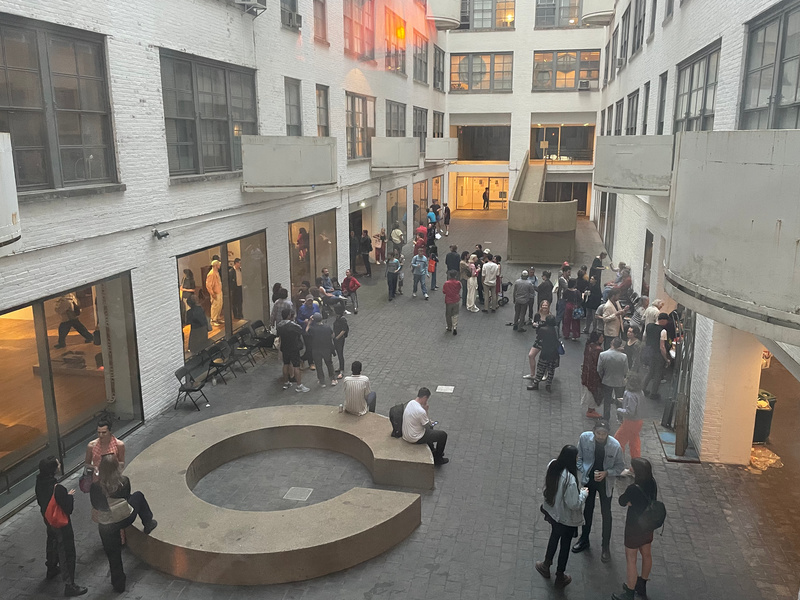
Hallier: There’s so many. I’m actually really interested in compiling, almost catalogs, per decade, to kind of recontextualize the gallery for a lot of people who don’t know the whole full history. The one that [often comes up is] Keith Haring. One of his first shows was here. The gallery wasn’t in the same exact location, but it was apparently a great show. There is a friend of mine who also was in a show back then. She’s older and she told me a lot. There are a lot of artists here who tell me about their experiences. There are too many to note but this [catalog] is something I would love to do if they give me another two years. You’re re-elected every two years.
Hallier: The way we select the shows is through an open call and then I put together a committee usually of members who have been gallery directors before or have been close to that position, so that they have a little bit of an overview. We look at all the submissions and we make our selections for the year. This year, I selected twelve but I think it’s going to be a little less next year because it’s a lot, one show per month.
In terms of a highlight, there’s one that I curated myself. When we accept proposals, sometimes there is a curator already attached to the proposal with the artist and then I work with them on their show, but it’s their show, really. So I curate only once in a while. One I curated last July was called Unnatural Processes and it was eight artists who have a very specific process and connection to the natural world, a way to talk about our relationship with our environment that I thought was really interesting. So we had, you know, high-tech stuff like 3D VR to someone who does a little potions based on an extract from a specific site. There was a very large gamut of media which is what I’m always interested in exploring. That was great but I would say another one—I’m always up for a challenge—is our exhibit at the end of the year.
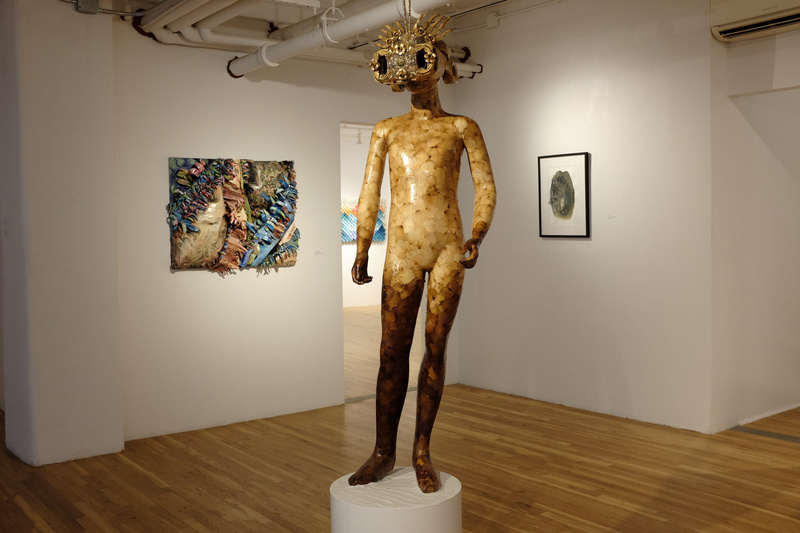
It’s basically all the artists at Westbeth, all the visual artists who want to be in the holiday show. So I end up with like 90 plus pieces of work that have sometimes no relationship whatsoever, but have to make sense of that. At first, I thought, “Wow, how is that even possible?!” But, you know, we did a good job, and it worked really well. It’s fascinating to see how there are dialogs between works that you would not expect, and it’s a great way to get to know the artists. Those two were really my favorites.
Hallier: We do look at, you know, women’s history month, gay pride, all those things, if it makes sense, we don’t want to stretch too much. But we also want to be cautious about not being only Westbeth people. We want to open the gallery to the outside but we also want the community to be respected and to be represented. I usually do a 50/50 split. Fifty percent hopefully come from within. There are solo shows that often showcase the work of 40 or 50-plus years of an artist, and it’s almost a mini-retrospective. And you have group shows, which our gallery is really meant for. It’s laid out in a certain way that is really good for that.
Then fifty percent [comes from art institutions]. We work with the Whitney, we have the Whitney staff every year. It’s coming out as the next show. And recently, we had the ISP, Independent Study Program, that moved right across from us on Washington Street. I love their forward-thinking. They work on curation and they also have artists in the studio. They had the show for the first time this year, and that was really, really great.
The current show is Rutgers’ MFA program. So we have a few institutions like that, and that is let’s say half of the other half, and then the rest is from the outside. A completely outside artist who has an idea for a group show. I generally go for the group show. We had one solo show that was really interesting by an Asian artist [Isa Ho] who did a piece on the Westbeth residents, and so she had a multimedia presentation. [Resonance – Westbeth Project] It was really excellent. It showed portraiture in all its different aspects, with different mediums representing the community. So [in that case] it made total sense to have a solo show for her, but that’s kind of rare.
Hallier: It’s really a spread out gallery. We have one big main gallery with glass windows that show into the courtyard, so people can hang out and there’s a really nice view right away to the main space of the gallery. Then we have three adjacent smaller spaces. One of them is pretty big actually, but they allow you to create different kinds of universes within the big area, and it’s beautiful. Westbeth is known for its architecture, especially the ceilings that are kind of wavy. It was the place where Bell Labs was with you know very heavy computers and equipment. It’s very 70s, there’s a lot of round corners and stuff. I love that style.
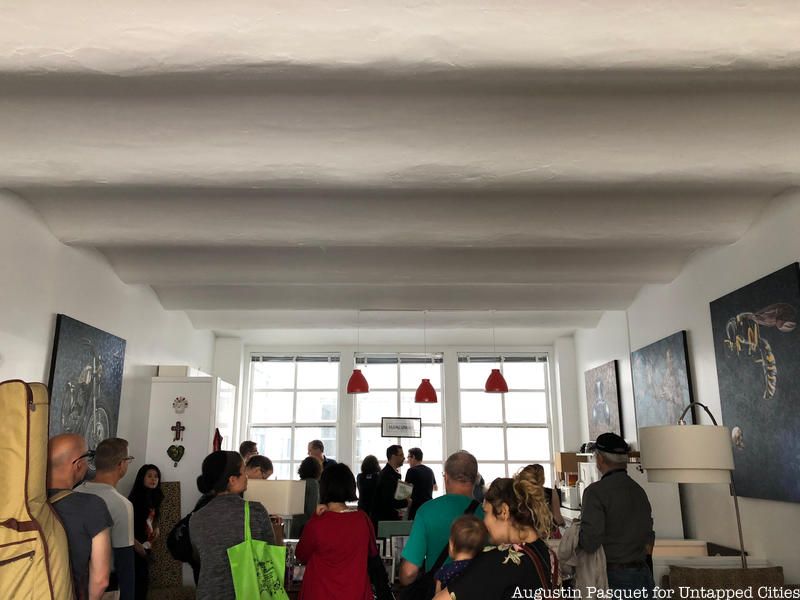
Hallier: Because we’re a not-for-profit, we can’t really afford [the big changes] unless [the artist] takes it on their own charge. The show right now looks very cool, they put sand all around the room, and it looks really beautiful. We always discuss [what the artist wants to do] but if there’s an addition of a wall or stuff like that, that we don’t really do. I think the gallery already has a lot of space to accommodate. Sometimes we’ll block out the windows so that a room can darken and have projections or things like that.
Hallier: Right now, we have the Rutgers MFA program, and it’s really interesting. They play a lot with convention on how they hang things, so you’ve got stuff on the floor, you have that sand I was telling you about. It’s a very nice show. It’s a lot of abstraction, it’s a good reflection on contemporary art right now. Coming up, we have the Whitney staff, as I was saying, which brings a huge crowd. The openings can get very, very busy.
We have also, the ESKFF, it’s the Eileen S. Kaminsky Family Foundation. It’s in New Jersey, Mana Contemporary. It’s a big contemporary art space, it’s wonderful. I had a residency there, and Eileen has a collection of art that is pretty amazing. So that’s one of the people I invited to do a show.
Then I’m going to create a show that’s called Up Close from Afar. It’s about foreign people looking at New York or New Yorkers looking at the outside world. So mixing those different visions. It’s mostly New York-centric but the artists are from somewhere else.

Hallier: Yeah, it’s going to be really interesting. That’s the fascinating thing, when you curate you discover a lot of new stuff, new artists. God knows, there are a lot of artists in New York, and a lot of good ones too! Which is amazing. And we have the global art project also. That title is We Are All Immigrants. So that’s going to be another show that’s a little bit on the same note. And then we’ll have our winter show again.
Hallier: I have a solo show coming out. I’ve started working with flower petals for a few years now, and it’s just wonderful. It keeps giving me ideas, different ways to manipulate the material and to adapt it. I did this series, that started actually at this residency at Mana Contemporary that I was referring to previously. It’s called Déflorée which means deflowered. Which obviously refers to the flowers, and also it’s about my sexual history. It mixes the beautiful and difficult, there are complex stories. It goes from childhood when you become sexually aware, and then there’s a section on youth, and then there’s motherhood, and then there’s maturity, which is what I’m getting into. There’s nothing graphic.
I love working with [the petals] because it’s very intuitive. I did a lot of more conceptual work [previously]. Especially working with technology, you always have to plan in advance, or even when you do sculpture. But the flower petals allow me to be much more connected. It’s a good image of femininity in some ways, very resilient, slightly transformed and man-made, but still very natural.
[The exhibit] is a mix of this and drawings that are actually a compilation of doodles, the kinds of things you do without completely thinking about it, like recurrent drawings or forms that I’ve found in my notebooks, automatic drawings. So, connecting with the unconscious somehow, finding ways to unlock things visually. The mix, it’s interesting, it surprises me as well. It comes in and out between figurative elements and the abstraction of the flower petals. It’s pretty large format and I’m really excited about that. It will be at the Hudson Guild Gallery.
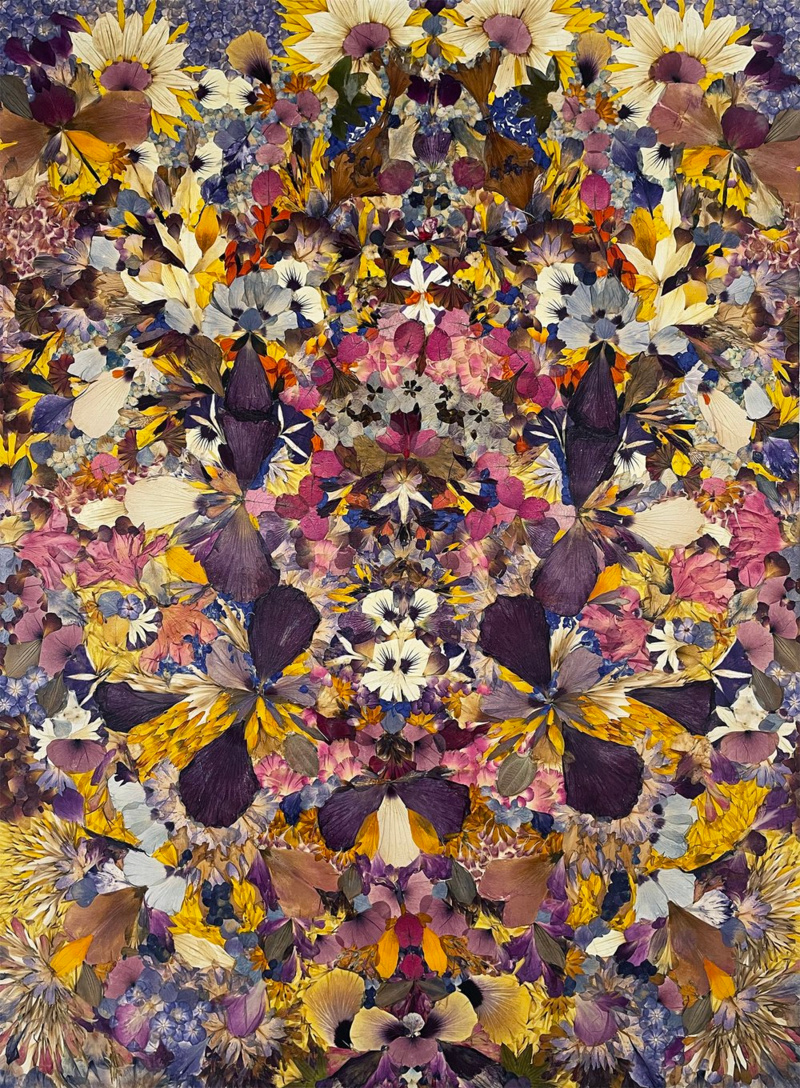
Hallier: See a lot of shows, go to a lot of openings, and apply, apply, apply. Look for all those opportunities. The not-for-profit is a real opportunity when you start to get to know other artists and start to network. You need a lot of peers. You need a lot of support. The show that I curate is usually people that I’ve known, that I’ve worked with, or that have been recommended, and that is pretty much how it works, usually.
Hallier: I feel like it’s more accessible than my experience in France. It seems more cliquey in France, like you have to go through the right path to be allowed into certain areas. I know it’s a little cheesy to say the land of opportunity and all that, but there is definitely this freedom, you know, which sometimes allows for the worst, but also allows for the best. And it is, I think, very important for an artist to feel like there is always this possibility, right? That’s, in my experience, pretty unique.
Hallier: More affordable so more artists and more diversity can be at the heart of the city, and not just sent away from it.
Hallier: Governors Island! I mean, a lot of people know it now. I had a residency in 2010 and I thought I had found this perfect secret. You take a boat for five minutes. No ticks. You can roll in the grass. It’s beautiful. There’s all this kind of weird history, like it’s really the very beginning of Manhattan. The first person who arrived here I think went to Governor’s Island first before Manhattan. So it’s really interesting.
Hallier: It’s great that it is so popular and people flock to it, it’s what it should be. But there are a lot of artist residencies, and not for profits, and art events. And that’s really great too. That’s definitely one of my favorite places.
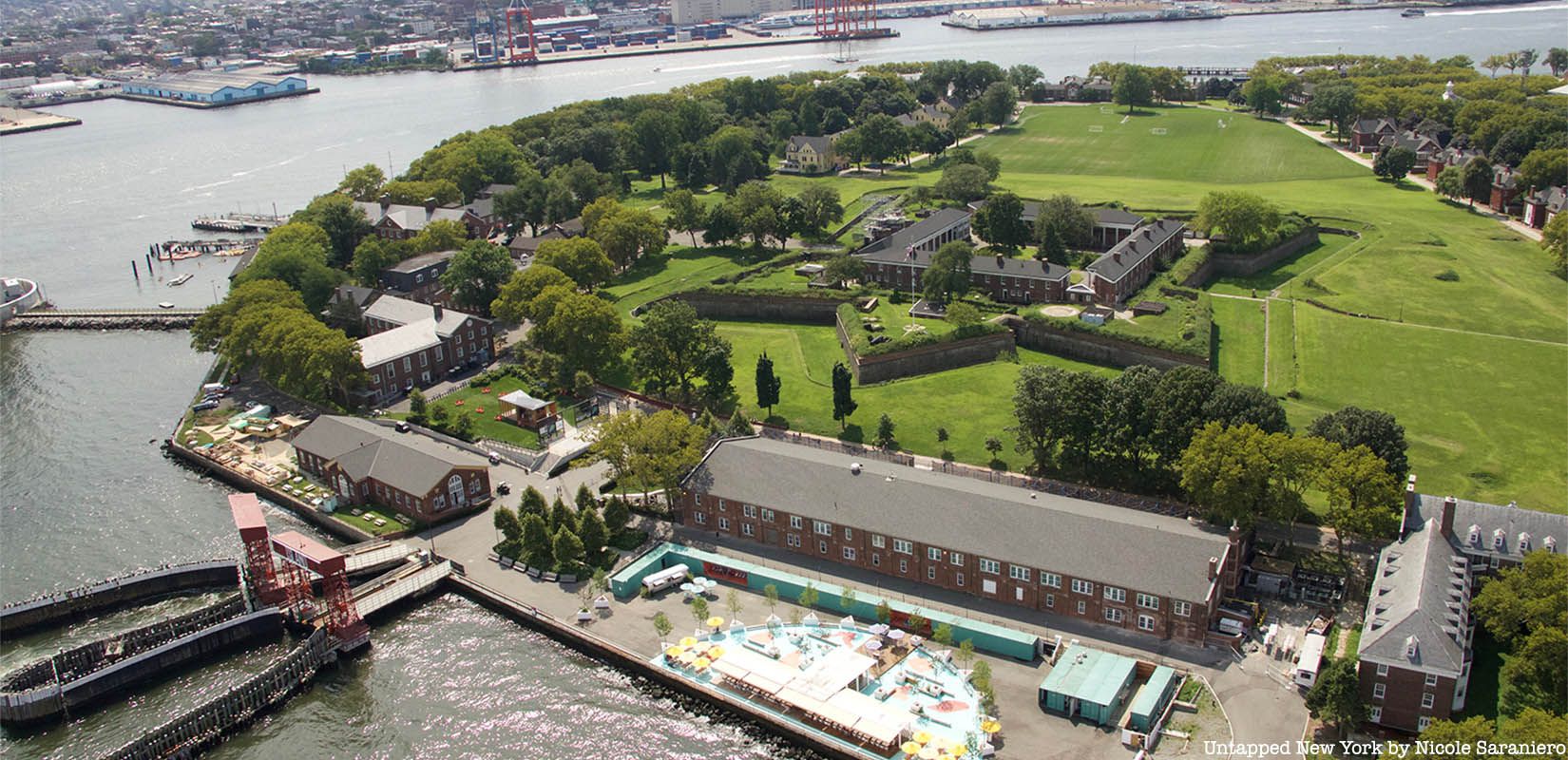
Hallier: …I’ve never been to the Statue of Liberty, but I don’t know that I really want to!….I don’t know. Some people were telling me about this crazy high building with all the glass mirrors.
Hallier: Yea, yea. I don’t know [what’s on my bucket list]. Teaching actually is really interesting, because I teach for Title One schools, so they’re all the ones that are very far and I discovered a lot of neighborhoods. Right now, I’m doing a mural in Long Island City, in an area that I would have never been and I love that I get to discover. We did a mural project with a family court in the Bronx. So that’s a good way to discover places.
Hallier: When I had my daughter we had to go back to France for some visa issue for a couple of years and when I came back, at the time, I was working on an application doing interface design and stuff like that. I came back to New York and I was like, “I don’t want to do this anymore.” That’s when I found this program, the Community Work Project, and there’s a teaching artist project, and you basically get trained as a teaching artist. I thought that would be perfect. I’d rather teach kids than lie to them by trying to sell stuff through social media, which is the area that I was working in, in advertising. It was very much like, how do we trick people? And it gets a little old for me. So I was like, eh yeah, I want to go teach the kids how to be creative.
I work with creative artworks as well, which is another non-profit. They work with youth development so they offer first jobs for kids between 17 and 22. That was the group that I had in the Bronx. We painted a mural for the family court, and it was an amazing experience. It really changed my whole view on a community that I got to know. That was extremely enriching for me.
You can visit Westbeth Gallery Wednesday through Sunday from 1pm to 6pm. See a schedule of all upcoming 2024 shows on the Gallery’s website. Learn more about the open call and how to apply for the 2025 season here!
Subscribe to our newsletter